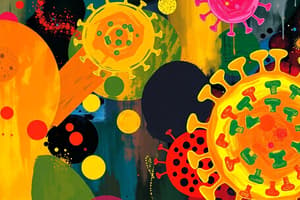Podcast
Questions and Answers
Which of the following is the most accurate comparison between the lytic and lysogenic cycles of a virus?
Which of the following is the most accurate comparison between the lytic and lysogenic cycles of a virus?
- The lytic cycle is characterized by the integration of viral DNA into the host's chromosome, whereas the lysogenic cycle results in immediate cell lysis
- The lytic cycle is specific to bacteriophages, while the lysogenic cycle is common in animal viruses.
- The lytic cycle involves immediate host cell destruction, while the lysogenic cycle incorporates viral DNA into the host genome without immediate destruction. (correct)
- In the lytic cycle, the virus remains dormant, while in the lysogenic cycle, it actively replicates and kills the host cell.
During a lysogenic infection, what is the viral DNA called when it is integrated into the host cell's chromosome?
During a lysogenic infection, what is the viral DNA called when it is integrated into the host cell's chromosome?
- Capsid
- Prophage (correct)
- Reverse transcriptase
- Viroid
Why are viruses considered obligate parasites?
Why are viruses considered obligate parasites?
- They can synthesize their own proteins.
- They can survive independently in the environment.
- They are capable of producing their own energy.
- They can only replicate inside a host cell. (correct)
How do latent viruses differ from viruses that cause acute infections?
How do latent viruses differ from viruses that cause acute infections?
Which structural feature distinguishes a bacterial cell from a eukaryotic cell?
Which structural feature distinguishes a bacterial cell from a eukaryotic cell?
How does Gram staining differentiate between different types of bacteria?
How does Gram staining differentiate between different types of bacteria?
What role do histamines play in the inflammatory response?
What role do histamines play in the inflammatory response?
How does the skin act as a barrier against pathogens?
How does the skin act as a barrier against pathogens?
What is the primary difference between B lymphocytes and T lymphocytes in the humoral immune response?
What is the primary difference between B lymphocytes and T lymphocytes in the humoral immune response?
How do live attenuated vaccines work to provide immunity?
How do live attenuated vaccines work to provide immunity?
Flashcards
What are viruses?
What are viruses?
Non-living entities that require a host to replicate; composed of genetic material (DNA or RNA) surrounded by a protein coat.
What is a bacteriophage?
What is a bacteriophage?
A virus that infects bacteria. Basic structure: capsid head, tail fibers, and a DNA core.
Lytic vs. Lysogenic Cycle
Lytic vs. Lysogenic Cycle
Lytic cycle involves the destruction of the infected cell and its membrane. Lysogenic cycle involves incorporating viral DNA into the host cell's DNA to replicate it.
Viruses as obligate parasites
Viruses as obligate parasites
Signup and view all the flashcards
What is conjugation?
What is conjugation?
Signup and view all the flashcards
What is a Pathogen?
What is a Pathogen?
Signup and view all the flashcards
First line of defense
First line of defense
Signup and view all the flashcards
Antigen vs. Antibody
Antigen vs. Antibody
Signup and view all the flashcards
B cells vs. T cells
B cells vs. T cells
Signup and view all the flashcards
What is a vaccine?
What is a vaccine?
Signup and view all the flashcards
Study Notes
Viruses:
- The classification of viruses as living or non-living is debatable
- Viruses possess genetic material (DNA or RNA) and can evolve, yet they lack cellular structure and cannot reproduce without a host.
- Viruses contain a nucleic acid core (DNA or RNA) surrounded by a protein coat called a capsid, some also have an envelope.
- Bacteriophages are viruses that infect bacteria, with a structure including a capsid head, tail sheath, and tail fibers
- A virus that attacks bacteria is called a bacteriophage
Lytic vs. Lysogenic Cycles:
- The lytic cycle involves viral replication and destruction of the host cell, while the lysogenic cycle incorporates viral DNA into the host genome.
- Lytic infection:
- Attachment: Virus binds to the host cell.
- Penetration: Virus injects its genetic material.
- Replication: Viral DNA replicates, and viral proteins are synthesized.
- Assembly: New viral particles are assembled.
- Release: Host cell lyses, releasing viruses.
Lysogenic Infection:
- During lysogenic infection, viral DNA integrates into the host cell's chromosome, becoming a prophage.
- The prophage can remain dormant, replicating along with the host cell, or it can enter the lytic cycle due to activation.
- When a prophage becomes active, the viral DNA excises from the host chromosome, initiating the lytic cycle.
- The host cell will then undergo lysis, releasing new viral particles.
- Retroviruses are viruses that use reverse transcriptase to convert their RNA genome into DNA, which integrates into the host cell's DNA.
- An example of a retrovirus is HIV (Human Immunodeficiency Virus).
- Viruses are obligate parasites because they lack the cellular machinery necessary for replication and rely entirely on a host cell to reproduce.
- Latent viruses become active due to various triggers, such as stress, weakened immunity, or changes in environmental conditions.
- Viruses cause disease by disrupting normal cell function, inducing inflammation, and triggering immune responses that can damage tissues.
- Viruses harm cells through lysis (rupturing the cell), releasing toxins, or altering cell growth.
Bacteria:
- Bacterial cells differ structurally from eukaryotic cells by lacking a nucleus and membrane-bound organelles.
- Bacterial cells also possess a cell wall composed of peptidoglycan.
- Gram staining distinguishes bacteria based on their cell wall structure.
- Gram-positive bacteria have a thick peptidoglycan layer and stain purple.
- Gram-negative bacteria have a thin peptidoglycan layer and an outer membrane, staining pink or red.
Bacterial Shapes and Arrangements:
- Bacteria can have various shapes, including cocci (spherical), bacilli (rod-shaped), and spirilla (spiral).
- Bacteria can arrange themselves as single cells, pairs (diplo-), chains (strepto-), or clusters (staphylo-).
- Bacteria move using flagella, pili, and through gliding mechanisms.
- Not all bacteria are motile; some are non-motile.
- Obligate aerobes require oxygen for growth.
- Obligate anaerobes cannot survive in the presence of oxygen. Facultative anaerobes can grow with or without oxygen. Bacteria grow and reproduce through binary fission, a form of asexual reproduction.
Bacterial Conjugation:
- Conjugation is the transfer of genetic material between bacterial cells through direct contact.
- Conjugation can be considered a "pseudo" sexual process because it involves genetic exchange but not the formation of a zygote.
- Bacteria can cause disease by producing toxins or inducing harmful immune responses.
- Bacteria obtain energy and nutrients through various methods, including:
- Autotrophs: Photosynthesis or chemosynthesis
- Heterotrophs: Absorption or ingestion of organic compounds.
Bacterial Survival:
- Bacteria survive in unfavorable conditions by forming endospores, which are dormant, highly resistant structures.
- Positive impacts of bacteria:
- Nutrient cycling
- Production of antibiotics and food products
- Negative impacts of bacteria:
- Causing diseases
- Spoilage of food
Disease and the Immune System:
- A pathogen is any organism or agent that can cause disease.
- The first line of defense against pathogens includes physical and chemical barriers such as skin, mucous membranes, tears, and saliva.
- The skin acts as a physical barrier, while tears, saliva, and mucous membranes contain antimicrobial substances.
- Pathogens might enter the body through breaks in the skin, respiratory tract, digestive tract, or urogenital tract.
- White blood cells (leukocytes) involved in the innate immune response include neutrophils, macrophages, and natural killer cells.
- The inflammatory response is a localized reaction to infection or injury, characterized by redness, swelling, heat, and pain.
- Histamines are released by immune cells, causing vasodilation and increased permeability of blood vessels.
- Pus is composed of dead white blood cells, bacteria, and cellular debris. A fever is beneficial because it inhibits the growth of pathogens and enhances the immune response.
- An antigen is any substance that triggers an immune response.
- An antibody is a protein produced by the immune system that recognizes and binds to a specific antigen.
Humoral Response:
- The humoral response involves the production of antibodies by B lymphocytes.
- B cells recognize antigens and differentiate into plasma cells, which secrete antibodies.
- Antibodies bind to antigens and neutralize them or mark them for destruction. Examples of lymphocytes are:
- B lymphocytes: produce antibodies
- T lymphocytes: mediate cellular immunity and help activate B cells.
- The immune system creates a "memory" of an infection through the formation of memory B cells and memory T cells.
- Memory cells enable a faster and more robust response upon subsequent exposure to the same antigen.
- The primary immune response occurs upon initial exposure to an antigen and is slower and less intense.
- The secondary immune response occurs upon subsequent exposure to the same antigen and is faster, stronger, and more prolonged due to memory cells.
Cell-Mediated Response:
- Cell-mediated response involves T lymphocytes, which directly attack infected cells or pathogens.
- Killer T cells (cytotoxic T lymphocytes) recognize and kill infected cells by releasing cytotoxic molecules.
- Passive immunity is the transfer of antibodies from one individual to another, providing temporary protection.
- Examples of passive immunity:
- Antibodies passed from mother to fetus
- Injection of antibodies (immunoglobulin).
- Active immunity is acquired through exposure to an antigen, stimulating the immune system to produce antibodies and memory cells.
- Active immunity can be acquired through:
- Natural infection or vaccination
Vaccines:
- A vaccine is a substance that contains antigens that stimulate an immune response, providing protection against a specific disease.
- Types of vaccines:
- Live attenuated vaccines: weakened form of the pathogen.
- Inactivated vaccines: killed pathogens.
- Subunit vaccines: contain specific antigens from the pathogen.
- DNA/RNA vaccines: deliver genetic material encoding antigens, stimulating cells to produce the antigens.
- Herd immunity occurs when a large proportion of a population is immune to a disease, providing protection to susceptible individuals.
- Herd immunity protects vulnerable populations such as infants, the elderly, and immunocompromised individuals.
Studying That Suits You
Use AI to generate personalized quizzes and flashcards to suit your learning preferences.
Related Documents
Description
Explore the structure, characteristics, and classification of viruses. Understand the differences between the lytic and lysogenic cycles including attachment, penetration, replication, assembly, and release.




